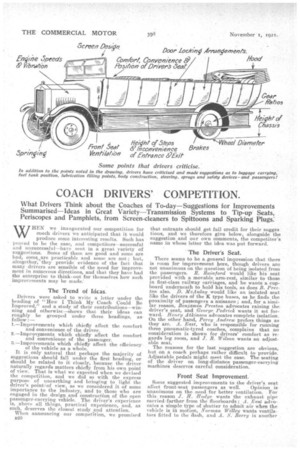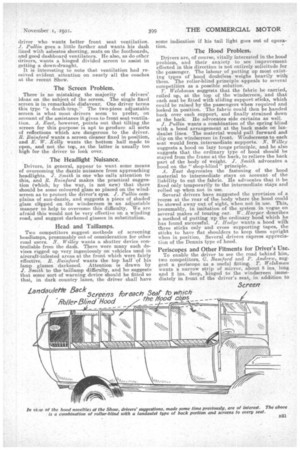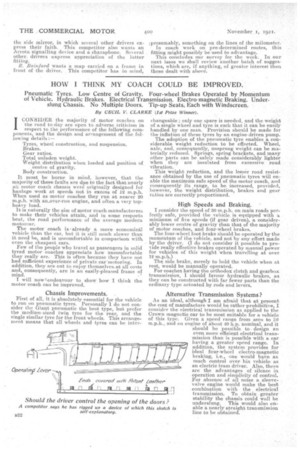COACH DRIVERS' COMPETITION.
Page 10

Page 11

Page 12

If you've noticed an error in this article please click here to report it so we can fix it.
What Drivers Think about the Coaches of To-day—Suggestions for Improvements Summarised—Ideas in Great Variety—Transmission Systems to Tip-up Seats, Periscopes and Pamphlets, from Screen-cleaners to Spittoons and Sparking Plugs:
WHEN we inaugurated our -competition for coach drivers we anticipated that it would produce some interesting results. Such has proved to be the case, and competitors—successful and unsuccessful—have sent in a great variety of suggestions. Some of them are good and some are bad, some_,,are practicable and some are not ; but, altogether, they provide evidence of the fact that many drivers are sensible of the need for improvement in numerous directions, and that they have had the enterprise to think out for themselves how such improvements may be made.'
The Trend of Ideas.
Drivers were asked to write a letter under the heading of " How I Think My Coach Could Be Improved," and a study of their contributions—winning and otherwise—shows that their ideas can roughly be grouped under three headings, as follow :— 1.—Improvements which chiefly affect the comfort and convenience of the driver.
2.—Improvements which chiefly affect the comfort and convenience of the passenger.
2.—Improvements which chiefly affect the efficiency of the vehicle as a whole.
It is only natural that .perhaps the majority of suggestions should fall under the first heading, or should be related to it closely, because the driver naturally regards matters chiefly from his own point of view. That is what we expected when we devised the competition, and we did so with the express purpose of unearthing and bringing to light the driver's pointiof view, as we considered it of some importance to the industry, and to those who are engaged in the design and construction of the open passenger-carrying vehicle. The driver's experience is, above all things, practical experience, and, as such, deserves the Closest study and attention.
When announcing our competition, we promised n20 • that entrants should get full credit for their sugges tions, and we therefore give below, alongside the suggestion and our own comments, the competitor's name in whose letter the idea was put forward.
"'The Driver's Seat.
There seems to be a general impression that there is room for improvement here, though drivers are not unanimous on the question of being isolated from the passengers. R. Rainford would like his seat provided with a movable arm-rest, similar to those in first-class railway carriages, and he wants a cupboard underneath to hold his tools, as does B. Preston also. D. McAulay would like an isolated seat like the drivers of the K type buses, as he finds the proximity of passengers a nuisance ; and, for a similar reason, Benjamin Preston advocates raising the driver's seat, and George Pedrick wants it set forward. Henry Atkinson advocates complete isolation. On the other hand, Percy Andrew prefers things as they are. A. East, who is responsible for running three pneumatic-tyred coaches, complains that no consideration is shown for drivers' comfort as regards leg room, and T. B. -Wilson wants an adjustable seat.
The reasons for the last suggestion are obvious, but on a coach perhaps rather difficult to provide. Adjustable pedals might meet the case. The seating of the driver on long-distance passenger-carrying machines deserves careful consideration.
Front Seat Improvement.
Some suggested improvements to the driver's seat
affect front-seat passengers as well. Opinion is unanimous on the need. for better ventilation. For this reason 1. H. Hodge wants the exhaust pipe carried farther from the floorboards ; A. East advocates a simple type of shutter to admit air when the vehicle is in motion, Arai-man Willey Wants ventilators fitted to the dash, and A. S. Berry is another driver who wants better front seat ventilation. J. Pullin goes a little farther and wants his dash lined with asbestos sheeting, mats on the footboards, and good dashboard ventilators. He also, as do other drivers, wants a hinged divided screen to assist in getting a down-draught.
It is interesting to note that ventilation had received evident attention on nearly all the coaches at the recent Show.
The Screen Problem,
There is no mistaking the majority of drivers' ideas on the subject of the screen. The single fixed screen is in remarkable disfavour. One driver terms this type "a death-trap." The two-piece adjustable screen is what most drivers seem to prefer, on account of the assistance it gives to front seat ventilation. A. East, however, points out that tilting the screen for this purpose is apt to produce all sorts of reflections which are dangerous to the driver. R. Rainford wants a screen cleaner fixed in position, and E. W. Kelly wants the bottom half made to open, and not the top, as the latter is usually too high for the driver to look over.
• The Headlight Nuisance,
Drivers, in general, appear to want some means of overcoming the dazzle nuisance from approaching headlights. J. Smith is one who calls attention to this, and R. Rainford makes the practical suggestion (which, by the way, is not new) that there should be some coloured glass so placed on the windscreen as to protect the driver's eyes. J. Pullin complains of sun-dazzle, and suggests a piece of shaded glass cli,pped on. the windscreen in an adjustable manner to help to overcome this difficulty. We are afraid this would not be very effective on a winding road, and suggest darkened glasses in substitufion.
Head and Taillamps.
Two competitors suggest methods of screening headlamps, presumably out of consideration for other road users. N. Willey wants a shutter device controllable from the dash. There were many such devices rigged up very ingeniously on vehicles used in aircraft-infested areas at the front which were fairly effective. R. Rainford wants the top half '9f his lamp glasses darkened. Attention is drawn by J. Smith to the taillamp difficulty, and he suggests that some sort of warning device should be fitted so that, in dark country lanes, the driver shall have
some indication if his tail light goes out of operation.
The Hood Problem.
Drivers are, of course, vitally interested in the hood problem, and their anxiety to see improvement effected in this direction is not entirely solicitude for the passenger. The labour of putting up most existing types of hood doubtless weighs heavily with them. The roller-blind principle appeals to several competitbrs as a possible solution.
T. Welshman suggests that the fabric be carried, rolled up, at the top of the windscreen, and that each seat be fitted with sliding support sticks, which could be raised by the passengers when required and locked in position. The fabric could then be handed back over each support, and finally strained down at the back. He advocates side curtains as well.
J. Pullin, wants a combination of the spring blind with a hood arrangement at the back made on Iandaulet lines. The material would pull forward and clip on the windscreen in front. Windsereens to each seat would form intermediate supports. N. Willey suggests a hood on lazy tongs principle, and he also suggests that the ordinary type of hood should be stayed from the frame at the back, to relieve the back part of the body of weight. J. Smith advocates a hood on the " shop-blind ' principle. A. East deprecates the fastening of the hood material to intermediate stays on account of the liability to cut the fabric. He advocates that it be fixed only temporarily to the intermediate stays and rolled up when not in use. Several drivers have suggested the provision of a recess at the rear of the body where the hood could be -stowed away out of sight, when not in use. This, presumably, in imitation of the system in vogue on several makes of touring car. W. Harper describes a method of putting up the ordinary hood which he has found successful. J. Hodye wants a hood with three sticks only and cross supporting tapes, the sticks to have flat shoulders to keep them upright when in position. Several drivers express appreciation of the Dennis type of hood.
Periscopes and Other Fitments for Driver's Use.
To enable the driver to see the road behind him, two competitors, C. Bamford and P. Andrew, suggest a periscope as a useful fitting. 2'. Welsknian wants a narrow strip of mirror, about 8 Ms. long end 2 ins, deep, hinged to the windscreen immediately in front of the driver's seat, in addition to
the side mirror, in which several other drivers express their faith. This competitor also wants an Arrota signalling device and a eharaphone. Several other, drivers -express appreciation of the latter fitting.
R. 1?ainford wants a map carried on a frame in front of the driver. This competitor has in mind,
;presumably, something on the lines of the milometer. In coach work on pre-determined routes, this fitting might possibly be used to advantage. This concludes our survey for the week. In our next issue we Shall review another batch of suggestions, which are, if anything, of greater interest than those dealt with above.
































